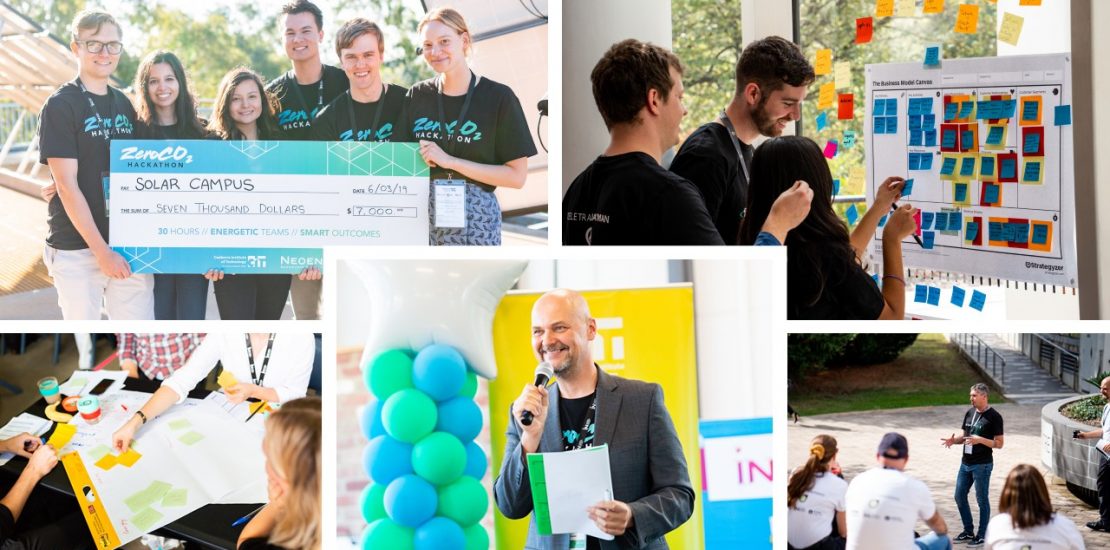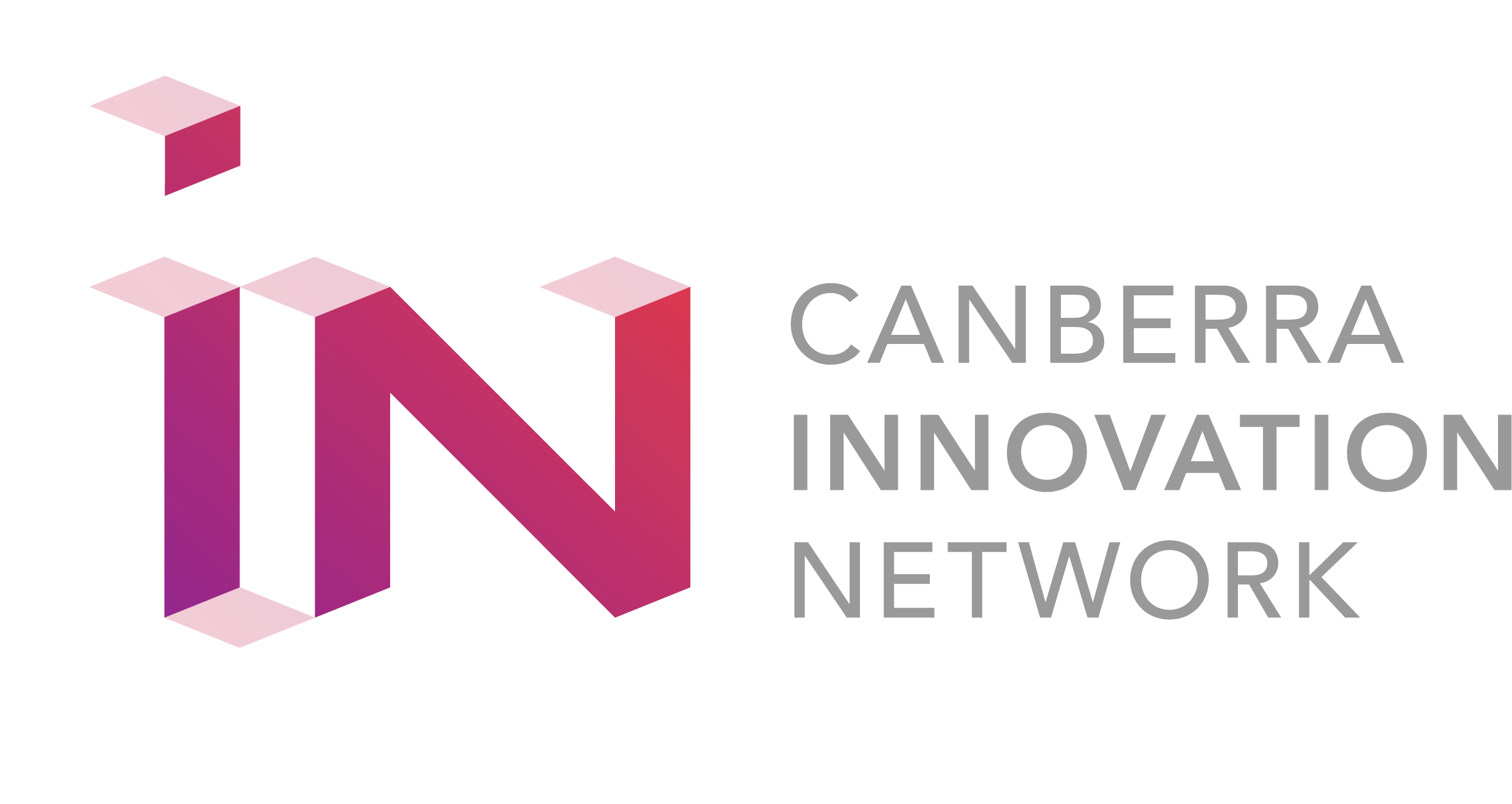- 25 September 2020
- Posted by: Canberra Innovation Network
- Category: Event News

Written by Petr Adamek, CEO of Canberra Innovation Network.
Originally launched as events to focus efforts of software developers to build and launch new apps, hackathons have evolved to exist in a variety of forms and have become a permanent feature within our innovation ecosystems. The question is – how can you best take advantage of these rather complex and intense events, to fuel your own progress as an innovative entrepreneur? At the Canberra Innovation Network, we believe you not only can – you should!
The term hackathon is a blend of two different terms: ‘hacking’ (putting something together in a fast and perhaps imperfect but functional manner, exploring unconventional pathways by those unknown/anonymous to the subject field) and ‘marathon’ (keeping at it without stopping until complete, whilst being subjected to an Olympic games competition type of atmosphere).
Nowadays, hackathons are not only about building software or hardware, they are about learning, solving problems, rapid prototyping, activating communities of interest and purpose, originating new businesses, scouting for breakthrough ideas by established organisations, responding to (or preventing) crises, exploring new horizon opportunities or even about identifying new innovation talent. The events themselves do not have to be limited to only a day or two of continuous work, they can be dispersed across several days or even weeks, they can include breaks to enable other stuff to happen as well and they are also not bound to a single location but can be virtual and available to global participation.
Hackathons are competitions of teams. While individuals can join and participate, fundamentally, they must enter the ‘race’ as teams. Mentors are typically available to provide input and expert views to help the teams shape their ideas. The best hackathons stimulate, encourage and enable interactions with users and customers, and focus on evaluating the level of engagement in the judging process. Why? Because early customer and user engagement increases the rate of adoption for any innovation, and ideas without at least a pathway to adoption are not even close to turning into innovations.
The competitions culminate with presentations of progress achieved during the hackathon, judging and awards. More and more often, hackathons not only stimulate solution development but also emphasise the post competition journey, viability, sustainability and impact of the proposed solutions. These elements (shared purpose, teamwork, time pressure, focus on customers and users, pitching, judging, rewards and potential post-competition pathways to impact) are the core ingredients of successful hackathons. Here are our top reasons why we believe that you should have a taste to inspire, energise and accelerate the progress for your own start-up, scaleup or innovation team!

1. Great ideas are not falling from trees
The story of Isaac Newton resting alone under an apple tree with the idea of gravity hitting him in the head in the form of a falling apple is a famous one – but one you cannot really replicate to come up with a world changing, innovative idea. To be inspired and evolve your thoughts on how to tackle a big problem in ways that have not been done before may require the opposite approach. We have found that people come up with more ground breaking and better shaped ideas when they immerse themselves in a stimulating environment; an environment that is conducive to these ideas freely emerging and floating around in creative conversations of diverse groups of people who all focus in the same direction. And interestingly, our idea generation capabilities seem to be amplified when we operate under time pressure.
There is something magical about the ideation momentum that hackathons create. You begin to come up with and bounce ideas you did not expect; one person adds to the ideas of the other person. And then, there is the idea multiplier effect – multiply that idea by the number of people in your team, times the number of teams, times the number of mentors. The pure exposure of a single idea to that many views, so quickly and efficiently positions it to emerge and evolve better. Hackathons, at least the way we run them at the Canberra Innovation Network with our partners, are in fact “idea-thons”. These are focused labs where ideas emerge, germinate and evolve through experiments into prototypes, business models and concise pitches that seek further engagement and support from the very industries they aim to change. We need better ideas and we need more ideas that we can evolve until proven not effective or changing the way we do things forever. And we believe we need these to be created and actioned faster than before to improve the way we adapt and address issues. New ideas are the lifeblood of innovation.
2. We work better in groups
Study after study shows that we work better in teams. We learn better, we get more creative, we are more productive and we have a higher threshold for stress. Groups make us progress faster. Groups are self-motivating. We mix skills, attitudes, experience and perspectives in these unique, difficult to replicate blends of mindsets and energy. By going through the ups and downs that hackathons can provide, we strengthen bonds, establish rules, learn the values of working together and create trust. These are all essential ingredients of peak performance, and we love to be part of something that makes us perform better.
But this group effect goes beyond what you can build in your own team. Humans tend to congregate and coexist in tribes; tribes have shared characteristics, purpose and values. The hackathon tribe (or cohort) brings people together during a relatively short period of time in one space (which as we have found can also be virtual) working on a task at an intensity that is unparalleled to how you work in your normal day in life. This shared effort connects people beyond their teams. While you are there to compete with others you are also there to collaborate with them. The shared hustle is more connecting than you could imagine. When you hear the final pitches, you find yourself proud of the other teams. You find yourself respecting their ideas and their effort as much as your own. This collective buy-in is incredibly rewarding and motivating. It is a result of the shared effort and experiences of peak performance towards a task and it is something you take with you beyond the hackathon.
3. Strengthen your purpose and motivation
While I do not suggest you become a serial hackathon participant, I suggest you follow and evaluate opportunities to engage with hackathons regularly. Do at least one hackathon per year. Take them as your annual dose of motivation. The mere presence of other people engaged in the same task can boost our motivation even if we do not actively collaborate. This is known as the social facilitation effect. Now imagine what happens when we actually do collaborate. When we hack, we belong. We self-actualise. We operate intensively at the upper levels of Maslow’s hierarchy of needs. Achieving and being in this ‘Hackathon Nirvana’ state is difficult when we work alone or isolated, but relatively automatic when in the midst of an intensive hackathon – and it is addictive and ‘infectious’. It affects us beyond the hackathon, we bring this motivation and deeper connection to the purpose into our life afterwards. I personally find this value proposition of a hackathon to a participant the most rewarding. Getting motivated is hard, keeping motivated even harder. Setbacks are a daily occurrence for innovators, entrepreneurs and people who are trying to change the status quo by doing something that is really hard to do. Without strong motivation, without an internalised and strongly felt purpose behind what we do, it is impossible. Hackathons provide a fantastic way to boost our own motivation – a resource for our progress and success.
4. Access expertise and mentoring on tap
Hackathons will enable you to build your networks rapidly and effectively. The connections and relationships we create in hackathon teams and among teams, last and transcend geographies. Hackathons do not only attract the competitors, they also attract sponsors, enthusiasts and experts. They attract people who understand their field well but still want to see what they can learn from the creative chaos of hackers working intensively on finding new ways. They typically volunteer as mentors and most of them selflessly give and share, and get inspired by what they observe. For you, as an entrepreneur, this is golden. A high concentration of diverse expertise and experience, primed and motivated to help you, share and encourage you to progress. When in a hackathon, you need to interact and engage with the mentors as much as you can. We are not saying you should agree with everything they say or do what they say. Exploit what they know, who they know and who they can connect you with. Let it add to what you are trying to achieve. Test your assumptions with the mentors. The faster you learn the faster you progress, and mentors can help you learn much faster.
5. A better way to deal with complexity
Hackathons are innovation playgrounds; they are set up to encourage you to ideate, explore, experiment, fail, learn and change. And then, repeat. Because time is precious and there is a countdown, you are driven to go through this loop faster and more often than in a non-hackathon setting. The cost of failure in a hackathon is mostly the value of the time you have invested and its opportunity cost. A hackathon “failure” is one of the cheapest ways to learn. By understanding where things don’t work we can reduce complexity and focus where chances are greater. Regarding your progress as an entrepreneur, not winning in a hackathon is even more important than winning because we tend to learn from failures more than from successes. If everyone says your idea is great – what have you learned? This built-in nature of permission to fail and acceptance of failure as part of the process (or even desired outcome) is better for innovation, and a better way to deal with complexity. As an entrepreneur you are destined to solve challenging and complex problems, and hackathons provide an excellent opportunity for you to learn how to do it inexpensively and fast.
Where can I do this?
If you would like to give it a go, look at Hackathons Australia, GovHack, Open Hack 2020 or the Canberra Innovation Network’s website. There is always something in the pipeline. Right now, you can be part of three competitions – if you are passionate about addressing difficult social issues through innovation and entrepreneurship, make sure you build a team and sign up for Hands Across Canberra & Snow Foundation Youth Homelessness Pathways Challenge. If you are excited about modernising transportation and accelerating the adoption of zero emission transport, build a team to compete in ActewAGL ZET Hack.
Make sure your team is diverse in terms of skills, knowledge and backgrounds. Include people from unexpected fields, they are more likely to bring thinking that is missing in the sector you are trying to change. Research the hackathon topic, have a look at startups that already address this field so that you do not reinvent the wheel. Clean your calendar during the hackathon. Sleep well in the lead up – you may get too excited to be able to rest during the battle. There may be a misconception that hackathons, innovation challenges and competitions are only for young people. This is not true at all, some of the best teams we have seen had a real mix of maturity and higher average age.
What happens after?
You have completed a hackathon, your idea was pre-validated and your feedback from users, customers, mentors and judges looks promising – what’s next? How do you maintain the momentum and build on the early excitement? A mistake would be to go back to your bedroom, garage, lab, or wherever you like to work in ‘isolation’. Make sure you embed yourself in an innovation community, access further mentorship, apply for grants, further your development through programs, accelerators, incubators – whatever your innovation ecosystem offers to give your project more fuel. Nurture your relationships with the customers that you initiated in the hackathon and keep them in the loop as you grow your pool of early users and adopters. If confident and almost ready (you will never feel ready) try to make your first sale (this can even be an R&D contract with a customer). Get professional advice. Clarify your IP position and find out if all team members are still interested in continuing. There are lots of things you need to consider, so collaborate with people who have done these things before.
In Canberra, there are a variety of organisations and groups that can help or refer you to the right sources of support. The best way to start your journey in our innovation ecosystem is to come and join us in a regular monthly (now virtual) innovation networking event or schedule an intro meeting with the team at the Canberra Innovation Network.
Some organisations that can help:
- Canberra Innovation Network – innovation grants, innovation and entrepreneurship workshops and mentoring, coworking, hackathons, business accelerator and incubator
- Mill House Ventures – social enterprise education and acceleration, impact venture investment, social enterprise mentoring
- Centre for Entrepreneurial Agri-Technology (CEAT) – for innovators and entrepreneurs focusing on agriculture and food systems
- Canberra Business Chamber – representing and supporting a broad range of Canberra businesses
- Launch on Northbourne – Cybersecurity, Defence and Space Tech focused precinct operated by UNSW Canberra
- Smart Energy Council – operates a Renewables Innovation Hub to empower collaboration and innovation in the renewable energy sector
- Canberra Cyber Security Innovation Node of AustCyber – connecting and growing Canberra’s cybersecurity capabilities and industry
- ACT Government Innovation, Industry and Investment team
So, now that you know why, where, how and what happens after – what will be your next hackathon?

